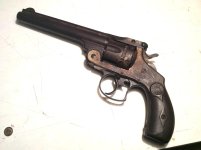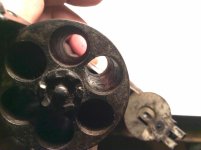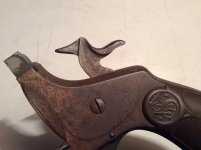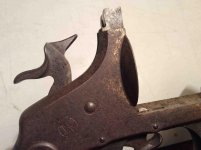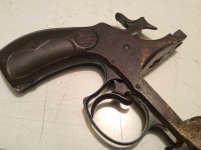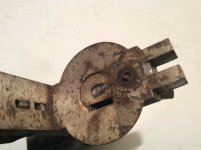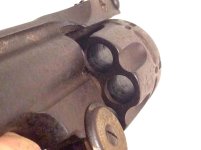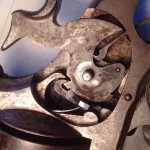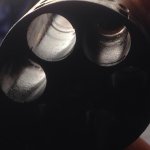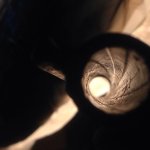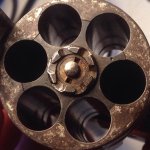Oliversound
Member
- Joined
- Aug 24, 2016
- Messages
- 20
- Reaction score
- 27
Hello, my name is Fabian, 52 years, i live in Uruguay.
My grand grand mother, arrives to Uruguay from england when she was a girl.
Years later, with 26 years she has been widow with 3 kids, in his farm. Her name was Lucy.
My mother allways talked to me about his revolver.
Lucy slept with his revolver under the pillow, and she always bring it with her when moving out of the farm.
So, from one week ago i have it at home, and i was learning what kind of revolver Lucy's uses.
It's a S&W new model 3 DA frontier .44 winchester ctg number 119XX.
It was chome, but now it's rusty.
I remember it whem i was a kid, it shines ( 40 years ago!)
I'll ask for a letter of autenticity, to know more about it.
The revolver is working fine ( at least is what i can see).
I'm very happy to have it, any comments are welcome!
Anyway i have some specifics doubts:
1. Confirm if it's a new model 3 frontier.
2. The barrel has a little rotational movement when not armed, but once armed it stays firm.
The barrel has a front to back movement of less than 1mm, un armed and less when armed but it moves a bit.
2. to know if its safe to test it. I want to know what Lucy felt under his hands when shooting.
3: Can i use 44/40 ammo on it?
like Hornady 44.40 cowboy action 205 grains ?
Hornady Manufacturing Company :: Ammunition :: Handgun :: Choose by Caliber :: 44-40 :: 44-40 205 gr Cowboy™
Here in my country we don't have a large offer of 44/40...
4: What's the best method to clean it without making loosing value?, can i polish it?
Well thanks all for your comments, and sorry for my english, Lucy will be dissapointed!, ja!
Fabian
My grand grand mother, arrives to Uruguay from england when she was a girl.
Years later, with 26 years she has been widow with 3 kids, in his farm. Her name was Lucy.
My mother allways talked to me about his revolver.
Lucy slept with his revolver under the pillow, and she always bring it with her when moving out of the farm.
So, from one week ago i have it at home, and i was learning what kind of revolver Lucy's uses.
It's a S&W new model 3 DA frontier .44 winchester ctg number 119XX.
It was chome, but now it's rusty.
I remember it whem i was a kid, it shines ( 40 years ago!)
I'll ask for a letter of autenticity, to know more about it.
The revolver is working fine ( at least is what i can see).
I'm very happy to have it, any comments are welcome!
Anyway i have some specifics doubts:
1. Confirm if it's a new model 3 frontier.
2. The barrel has a little rotational movement when not armed, but once armed it stays firm.
The barrel has a front to back movement of less than 1mm, un armed and less when armed but it moves a bit.
2. to know if its safe to test it. I want to know what Lucy felt under his hands when shooting.
3: Can i use 44/40 ammo on it?
like Hornady 44.40 cowboy action 205 grains ?
Hornady Manufacturing Company :: Ammunition :: Handgun :: Choose by Caliber :: 44-40 :: 44-40 205 gr Cowboy™
Here in my country we don't have a large offer of 44/40...
4: What's the best method to clean it without making loosing value?, can i polish it?
Well thanks all for your comments, and sorry for my english, Lucy will be dissapointed!, ja!
Fabian

